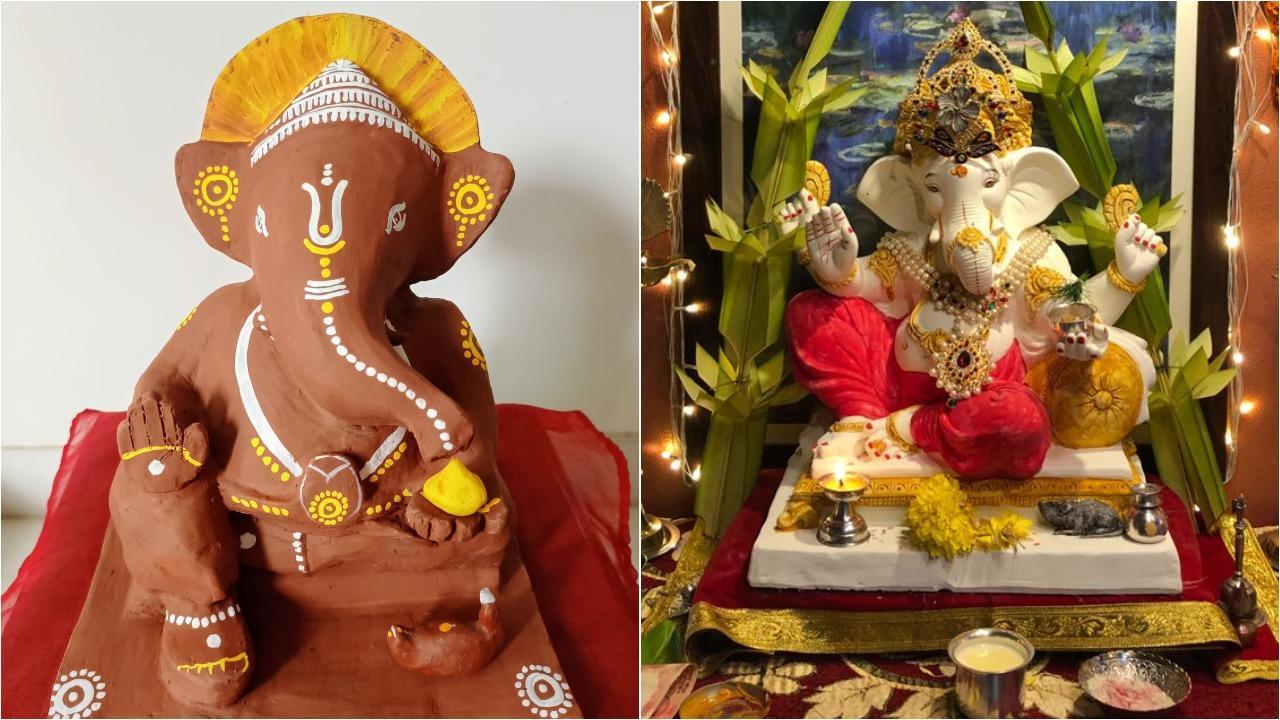Before the Covid-19 pandemic robbed large-scale city festivals of their grandiosity, Ganesh Chaturthi saw annual immersions at the famous beaches but the resulting pollution is what made these two Mumbaikars change the way they celebrate the earthly visit of the elephant-headed deity

Aishwarya Pimpley and Aneri Sheth take part in celebrations which include worshipping an eco-friendly Ganesha idol and adopting the zero-waste approach with decorations. Photo: Aishwarya Pimpley/Aneri Sheth
For Versova-based Aishwarya Pimpley’s family, switching to eco-friendly Ganesh Chaturthi celebrations came as a natural choice after a visit to Juhu beach about 15 years ago. The beach, which is one of the popular sightseeing spots in Mumbai has for long been the place for Mumbaikars to carry out their idol immersions during this time of the year.
"My parents came up with the idea of eco-friendly celebrations after we saw the sorry state of visarjan affairs at the beach, " she says. It also means that the Covid-19 pandemic hasn’t really interfered with their immersion plans, unlike in the case of many others, because they have been doing it indoors for over a decade. This year, like last year, will be no different.
Ganesh Chaturthi is one of the most widely celebrated festivals in the city – from the biggest to the smallest, the city sees many immersions over 10 days. However, the aftermath of the immersions—the pollution resulting from the floating garlands, decorations, broken idols and other non-degradable objects at beaches—has made many environmentally conscious Mumbaikars switch to eco-friendly and zero-waste celebrations.
Some are adopting both routes: eco-friendly celebrations and zero-waste, which means buying minimal reusable decorations. “We immerse the eco-friendly Ganesha idol in a huge drum on our terrace itself, and once it dissolves, the water is used for the plants in the society,” adds the city-based copywriter Pimpley, for whom the festival has always been a family celebration of both the elephant-headed deity and the environment.
Elsewhere in the city, 28-year-old artist and dancer Aneri Sheth has been among the newer converts of eco-friendly celebrations. A little over six years ago, she spotted the same kind of post-festival celebration deterioration of the environment at Juhu beach. It not only made Sheth change the way she celebrates the festival but also put her talents to good use. Being an artist, she immediately got to perfecting her Ganpati idols using terracotta mud and has been conducting workshops since then to encourage other people to make their own idols for the festival too. Like Pimpley, Sheth immerses her idol indoors in her bucket, and uses the water and flowers while gardening at home.
“There is no point in Ganpati worship if you destroy nature carelessly,” Sheth says. “Merely talking about eco-friendly celebrations doesn’t make sense because community worship, or in this case Ganpati festival, presents an opportunity for collective awareness,” the artist adds. Since she isn’t able to conduct her workshops in the last two years, Sheth has been making idols for people who want to adopt the approach. One doesn’t have to be an artist to start making the idols, she says, and it’s never too late to start, since many people are still indoors.
For all those who want to start making their own idols, Aneri details her process.
Make your own idol by Aneri Sheth
1. Batter the terracotta clay first to let the excess water from the clay flow out.
2. Start with the base and slowly ascend towards the top – from the base with Ganpati's seating, thighs and legs, tummy, chest, hands, then face and trunk, finally ending with the halo on the top.
3. Once it's all stuck together, start shaping the murti. After the initial shaping, the murti is left to dry for at least 24 hours.
4. Start the finishing -- like removing the excess clay and giving a more precise form – in stages. (This can last up to 4 stages of finishing, ending with a finish layer of water and brush)
5. Add a water-soluble coat of terracotta paint to give the red soil colour to the murti.
6. After that, with water soluble white and yellow paint, enhance the eyes and tilak along with little ornamentation to give it a finished look.
Zero-waste approach by Aishwarya Pimpley and Aneri Sheth
1. Use decorations that can be used every year.
2. Use natural flowers for the decorations as they are biodegradable.
3. Use natural clay or paint for the idols.
4. Recycle the plastic, which is given at the time of purchasing the terracotta clay.
5. Immerse the idol inside your house or on the terrace and use the water for your plants.
Also Read: Make the most of apples with these innovative dessert recipes by Mumbai chefs
 Subscribe today by clicking the link and stay updated with the latest news!" Click here!
Subscribe today by clicking the link and stay updated with the latest news!" Click here!









